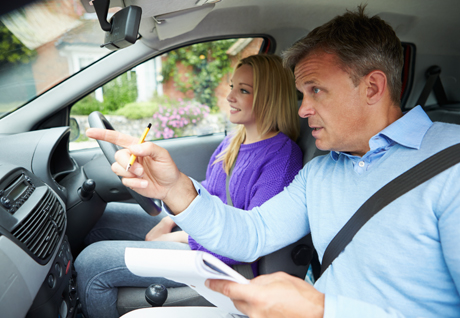Preparing for Your Driving Test
Before you go for the Road Test please make sure that the following requirements are met:
- You have done all classroom make-up classes
- You have turned in a Driver Education Approval Form
- You have completed all driving sessions
- You have paid the full tuition fee
- You have received an Illinois Driver Certificate (letter from the Secretary of State)
- You have completed 50 hours of practice driving with an adult
- You have held your permit for minimum of 9 months
- You are 16 years old
Driver's Education Course Completion Check

The driving test will allow you to demonstrate your ability to drive. You must provide a vehicle that is licensed and properly equipped for the driver’s license classification you are seeking. If the vehicle is registered in Illinois, it must display valid license plates as required by Illinois law.
You will be required to show proof of insurance inside the driver services facility. You will automatically fail the test if you violate any traffic law or commit any dangerous action while taking your test. You and the examiner are required to wear safety belts during the driving test.
During the basic test, which will allow you to drive passenger cars, you will be graded on your ability to do
the following:
- Start the vehicle. Check your vehicle controls, such as parking brake and mirrors. All the required equipment listed in “Illinois Rules of the Road” Chapter 11 must be working properly. Make all adjustments to seats, safety belts, mirrors and other equipment before you move your vehicle.
- Back the vehicle. You will back the vehicle about 50 ft. at a slow speed, straight and smoothly. Turn your head to the right and watch to the rear as you back.
- Turn about. You will turn around by using an alley on the left side of the street. Turn your left signal on before turning into the alley. Back the car out of the alley and stay on your side of the street.
- Park uphill. Turn on the signal for the side of the road on which you are going to park. Stop your vehicle parallel to the side of the road.
- If there is a curb against which you can wedge your front wheel, turn the front wheels sharply away from the curb. Your vehicle will roll against the curb. Set the parking brake or put the gear selector in “Park”.
- If there is no curb or a low curb, turn your wheels toward the side of the road on which you are parked. Set your parking brake or put the gear selector in “Park”. If your vehicle rolls, it should not roll into traffic.
- Start uphill. Release the parking brake, give the correct signal and look back. When it is safe, pull slowly out onto the street.
- Park downhill. Signal to the side of the road where you wish to park. Stop the vehicle parallel to the road. Whether there is a curb or not, always turn the wheels toward the side of the road where you are parked. When there is a curb, let your vehicle roll against the curb. Set the parking brake or place the gear selector in “Park”. If your vehicle rolls, it should not roll into traffic.
- Start downhill. Release your parking brake and relieve pressure on your tires by backing a little. Turn your wheels from the side of the road and use your turn signal. Look for oncoming traffic. When it is safe, pull slowly onto the street.
- Control your vehicle. You must obey all signs, controls and rights-of-way. Care must be taken to observe lane markings and give turn signals correctly.
